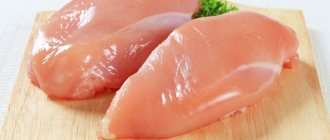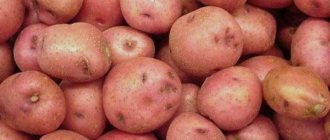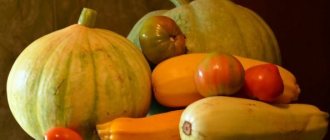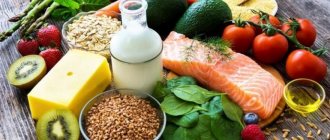Healthy eating concept for gastritis
Gastritis and gastric ulcer are at the top level of the hierarchy of all diseases of the upper digestive system. The main reasons include heredity, alcohol abuse, constant stress or poor diet.
The main strategic treatment is diet correction, the task of which is not only to satiate, but also to reduce the digestive load and the impact of an aggressive environment on the gastric mucosa. An important aspect is the preservation of normal microflora of the gastrointestinal tract and the normalization of metabolic processes.
Diet for gastritis and stomach ulcers: basic diet rules
In order for a diet for gastritis to bring the greatest benefit and help cope with the problem, it is recommended to understand the features of proper nutrition.
Basic rules that nutritionists insist on:
- Eat only warm food. Too cold or scalding food can provoke stomach irritation, which will result in additional complications and severe pain.
- It is advisable to eat chopped or grated food. Large particles are no less dangerous for the mucous membranes during gastritis than hot or cold food, and it should be borne in mind that it will take a lot of time to digest them. Another danger hidden in rough food is that the secretion of gastric juice increases.
- A prerequisite for successful treatment of gastric diseases (especially gastritis) is split meals. It is recommended to eat food at least five times a day in small portions.
- Correct your diet. Be sure to review the menu, exclude harmful foods, and add dishes that are healthy for the digestive organs.
- It is advisable to develop a menu with a nutritionist - the specialist will recommend dishes that are useful in an individual case.
Any diet for stomach diseases also requires correction of the drinking regime. If you have gastritis, you should not drink any drinks before meals; this helps normalize the production of gastric juice.
Basic Rules
The basis of the rules of dietary nutrition for gastritis and peptic ulcers is the organization of a diet that prevents the development of pathological processes. To do this, it is important to follow these rules:
- food should be warm (neither hot nor cold);
- food should be eaten in small portions of 6-7 approaches;
- during an exacerbation, it is necessary to consume semi-liquid food;
- food is ground before consumption;
- all medications should be taken strictly according to a specific schedule, if it is associated with meals.
Usually a Pevzner (classic menu for gastritis), table No. 1 for high or normal acidity (with a variation on table No. 1a and No. 1b ), table No. 2 for low acidity. When stable remission occurs or during recovery, table No. 15 .
Each type of special diet menu for stomach ulcers and gastritis requires adherence to a scheme and has a certain duration. With atrophic gastritis, widespread ulceration, an increased tendency to malignancy, and also after operations, the diet can be lifelong.
Diet No. 2
For atrophic gastritis of the stomach, a menu is usually prescribed that helps reduce acidity and reduces the load on the affected walls.
In this case, a special menu is prescribed - diet No. 2.
Diet information
This food is used during recovery or when the disease becomes chronic. The daily menu for patients with gastritis must be balanced.
You should avoid foods that require prolonged cooking. You should not eat food that can lead to irritation of the gastric mucosa and fermentation processes.
It is necessary to maintain a daily calorie intake of 2500 kcal and drink more than 1.5 liters per day. liquids and eat 5 times.
This is a so-called moderately gentle diet, following which protects the digestive organs from mechanical irritation. On the Internet there are always recipes for healthy dishes that are perfect for gastritis.
Products
The menu for atrophic gastritis can sometimes include fried foods, but without hard crust or breading. However, more often the patient should eat foods prepared by stewing, boiling, baking or steaming.
Authorized products:
- inconvenient foods, buns filled with boiled meat, eggs, rice and cottage cheese;
- low-fat soups with cereals in fish or meat broth;
- dietary types of meat;
- baked pears and apples;
- various crumbly cereals;
- butter;
- herbal teas;
- fermented milk products - kefir, cottage cheese, whole milk, mild cheese;
- scrambled eggs;
- various greens (dill, parsley), cloves, bay leaf.
Permitted and prohibited products
Despite the multiple restrictions on the diet menu for ulcerative gastritis, with imagination and a creative approach to nutrition, you can significantly diversify your food intake and make the menu varied. The basis of any dietary nutrition is the use of soups, semi-liquid pureed dishes, which can be supplemented with interesting permitted ingredients.
In addition, the beautiful presentation of the dish makes it more appetizing. Any steamed cutlets can be supplemented with herbs and tasty sauce to increase your appetite and fill you up well.
Authorized Products
Among the acceptable foods that must be included in the diet for ulcerative gastritis are the following:
- Soups . Simple, with low-fat meat or meat-free fish broth with the addition of cereals, noodles, and cream.
- Crackers , dried bread . Fresh bread is a difficult-to-digest, gas-forming product. If you are prone to constipation or severe dyspeptic disorders, it is recommended to use crackers. They are well digested and fully replace fresh bread.
- Meat and fish . The dietary table allows the use of lean meat (beef, poultry) and fish. If you prepare cutlets or meatballs, the minced meat for them must be twisted several times.
- Porridge . Cereal porridges with milk or water are ideally digested, satisfy hunger, and help quickly evacuate feces from the intestinal tract.
- Jelly and gelatinous products . Jellied meats, jellied meat made from lean beef, jelly based on berries - all these are preferred dishes for gastritis and peptic ulcers.
- Chicken eggs . The product can be eaten either soft-boiled or hard-boiled. For breakfast, it is preferable to cook a steam omelet with milk.
- Dairy and fermented milk products . It is better to choose milk and cream with a low fat concentration. It is recommended to eat kefir, cottage cheese, and sour cream.
Desserts can include marshmallows, jelly, honey, marshmallows, meringue, and non-sour berry jam. It is important to maintain a plentiful drinking regime. The preferred drinks for gastritis are jelly, warm water with honey, decoction of rose hips without sugar, dried fruit compotes, decoction of chamomile or string, green tea with milk.
Unacceptable Products
The following products should not be included in the diet for any diseases of the gastrointestinal tract:
- Any conservation. Marinades, pickles, hot or spicy foods should not be included in the medicinal diet. They are difficult to digest and have a severe irritating effect on the already damaged walls of the mucous membranes.
- Carbonated drinks, alcohol. These foods should be completely excluded from the diet. Alcohol aggravates the pathological process and can accelerate the malignancy of cells in cancerous tumors.
- Fresh bread and sweet pastries. Flour products complicate digestion and promote the release of a larger volume of gastric secretions. In addition, it provokes heartburn and gas formation.
Salt intake should be limited, but its complete exclusion should not be allowed due to the risks of developing electrolyte disturbances. If your doctor prescribes otherwise, salt should be eliminated gradually.
To treat peptic ulcers and gastritis with nutrition, you should adhere to a fractional diet. This is important for reducing the digestive load and reducing the secretion of gastric juice. Thus, fractional meals can be continued throughout life. Another advantage of this approach to nutrition is weight loss, which has a beneficial effect on the entire body.
Methods of proper nutrition
First, you need to figure out which foods are good and bad for gastritis, and you also need to remember that food should be taken in small portions; overeating is strictly not recommended. It is better to eat small portions 6 times a day than to load your sore stomach with hard work at one time.
List of approved products
List of allowed foods for gastritis of the stomach
- White bread, not just baked, but preferably yesterday’s bread;
- White bread crackers;
- Milk;
- Low-fat cottage cheese;
- Kefir;
- Ryazhenka;
- Meat;
- Fish;
- Soup;
- Boiled, finely grated vegetables;
- Egg;
- Freshly squeezed juices from pears, strawberries, apples, oranges, grapes.
List of prohibited products
List of prohibited foods for gastritis of the stomach
- Red and black pepper;
- Alcohol;
- Water with gases;
- Freshly baked bread (both white and black);
- Ice cream;
- Hard boiled egg.
Sample menu for the week
1 day
For breakfast, boiled milk rice porridge, 1 soft-boiled egg, black tea with milk. For lunch, borscht with beets and sour cream, boiled vegetables with steamed cod, crackers or biscuits, compote. For an afternoon snack, low-fat cottage cheese with sugar and sour cream, a decoction of rose hips. For dinner, steamed meatballs from chopped chicken, mashed potatoes, warm berry jelly. Before going to bed, you can drink honey with boiled milk.
Day 2
For breakfast, milk soup with noodles, a decoction of rose hips with honey, crackers. For lunch, carrot salad with vegetable oil, creamy broccoli soup, rice and breaded chicken breast. For an afternoon snack, a glass of milk with honey, a baked apple. For dinner, vegetable stew with fish (pink salmon, cod, pollock). For a late dinner, you can eat warm jelly and a toasted bun.
Day 3
In the morning, semolina porridge, green tea and baked apple. For lunch, soup with meatballs and noodles, pike perch baked in foil with vegetables. For an afternoon snack, jelly and crackers. For dinner, mashed potatoes, casserole with chicken and vegetables, compote. For dinner you can drink milk with honey and biscuits.
4 day
For breakfast, a steamed omelet, a glass of unsweetened dried fruit compote, a toasted slice of bread with cheese. For lunch, meatless rassolnik with sour cream, fresh cabbage salad, peas and vegetable oil, rice and trout steak. For an afternoon snack, jelly with a toasted bun. For dinner, mashed potatoes, beef meatballs with vegetable sauce, and a decoction of rose hips. For a late dinner, you can drink a decoction of chamomile with a baked apple.
5 day
For breakfast, rice porridge, cottage cheese with sour cream and honey. For lunch, vegetable soup, minced chicken meatballs with rice, vermicelli with vegetable sauce, berry jelly. For an afternoon snack, you can drink a chamomile decoction and eat a low-fat sweet casserole. For dinner, coarse wheat pasta, fish steak, bananas. Late dinner - milk with honey.
Day 6
For breakfast, steamed omelet with herbs and tomatoes, green tea with milk, biscuits. For lunch, pearl barley soup with chicken, steamed chicken cutlets with boiled buckwheat porridge, dried fruit compote. For an afternoon snack, fruit salad with yogurt and a decoction of rose hips. For dinner, beet salad, fish balls with rice and vegetables. For a late dinner you can eat sweet cottage cheese casserole and jelly.
Day 7
For breakfast, black tea with milk, semolina porridge. For lunch, soup with homemade noodles and chicken, boiled beet salad with prunes, pilaf with chicken. For an afternoon snack, berry jelly and banana-strawberry smoothie with cream. For dinner, boiled beef in sweet lingonberry sauce, mashed potatoes, black tea with sugar. Before bed, a glass of fermented baked milk or warm jelly.
On weekends, you can arrange fasting days, drink a lot of warm clean water, eat non-acidic fruits and vegetable salads. Thus, unload the intestines and prepare the body for the new week. A diet for peptic ulcers cannot be called a starvation diet, so it is not difficult to follow. For diabetes mellitus, the compiled menu must be approved by an endocrinologist.
Diet for gastritis and ulcers: rules for creating a menu
For ulcers and gastritis, it is recommended to adhere to a special diet, follow a number of restrictions and recommendations that will help quickly remove painful symptoms. You should completely exclude from your diet foods that can cause aggravation or worsen digestive processes.
A diet compiled taking into account all the features of the disease will prevent complications of gastritis, promote the healing of affected mucous tissues, and increase the effectiveness of drug treatment. To get the maximum benefit from food, it is better to immediately understand the features of the diet for gastritis and ulcers.
Diet for gastritis of the stomach: what is prohibited if an ulcer is diagnosed at the same time?
If you are worried about gastritis or an ulcer, the first thing to do is to understand the prohibited foods and completely eliminate them from the daily menu. The following can cause complications and deterioration of health:
- fatty fish and meat;
- chocolate, candy, ice cream;
- canned vegetables, canned meat and fish;
- smoked meats, pickles;
- sweet soda, kvass;
- sour fruits (exceptions are spinach, white cabbage, citrus fruits);
- sauce, especially mayonnaise (serve with sliced vegetables, mashed potatoes; milk gravy prepared with a small amount of fat is recommended);
- spicy vegetables (garlic, hot pepper, radish, onion);
- strong tea (especially sweet), coffee;
- baked goods with a lot of sugar, wheat flour, yeast.
The diet menu for gastritis and ulcers should also be arranged taking into account the peculiarities of heat treatment of products. Eating foods fried in vegetable oil or animal fats is strictly prohibited (with the exception of gastritis with low acidity, in such cases it is allowed to occasionally serve fried foods). Steaming or boiling is recommended; processing products in the oven is allowed.
Ulcer and gastritis: what is allowed?
For stomach diseases, the list of allowed foods is quite extensive, so it is easy to prepare a balanced meal that is beneficial for the digestive organs. For gastritis, the menu must include:
- Soups. Grinded first courses are most useful for ulcers and gastritis. The best option is puree soup with vegetable or low-fat broth.
- Fish, meat. Preference should be given to low-fat types. A prerequisite is to grind it before use; even tender chicken or rabbit meat can cause indigestion and provoke discomfort in the diseased stomach.
- Porridge. It is recommended to cook cereals only in water. If you need to diversify your diet a little, you can add a small amount of low-fat milk, but be sure to monitor the body’s reaction - if you experience severe pain after eating porridge, it is better to avoid using a dairy product.
- Vegetables. If you have gastritis, it is advisable not to eat it raw - steam it or boil it. Grind before serving.
- Fruits. Only non-acidic varieties can be added to the menu (fruits with a high percentage of sugar are also undesirable for gastritis). It is better not to eat fresh fruits - prepare rich compotes and jelly.
- Dairy products. It is allowed to consume only low-fat milk, cottage cheese, and cheese. Butter is allowed, but in limited quantities.
- Sweets. Continuing the diet, you are allowed to pamper yourself with sweets - marshmallows, homemade fruit marmalade, marshmallows.
- Bread, biscuits, crackers. If you eat bread for gastritis, give preference to yesterday's baked goods - fresh baked goods, especially hot ones, will certainly cause severe pain.
Pay special attention to drinks. For gastritis, herbal decoctions are considered mandatory (a drink made from rose hips is especially useful, normalizing acidity in the stomach), and green tea.
Menu for a week at home diet for gastritis, ulcers
When drawing up a diet menu for gastritis of the stomach, a progressive ulcer, take into account an important point - you should calculate the diet for several meals. The optimal number of meals per day is at least five times (breakfast, first snack, lunch, second snack, dinner). The last meal should be taken no later than two hours before bedtime; it is better to go to bed with a slight feeling of hunger.
It’s not difficult to organize a menu for a week’s diet for gastritis, taking into account all the recommendations of nutritionists, especially if you know which foods should prevail in the diet and which ones are best avoided.
Monday:
- Bread, oatmeal, boiled egg, prepare a herbal decoction from drinks (steam 5-7 rose hips with a glass of boiling water).
- Compote (for cooking, use only dried fruits, it is better not to add prunes), sponge cake.
- Pumpkin puree with steamed zrazy, vegetable soup, tea (add a little milk and sugar to improve the taste, but only in the absence of exacerbations of gastritis).
- Toast with a glass of kefir.
- Steamed noodle bowls, sliced vegetables (vegetable oil dressing), cocoa with milk.
Tuesday:
- Buckwheat porridge, soufflé made with skim milk, black or green tea.
- Sweet jelly made from oatmeal.
- Vegetable soup with rice, boiled carrot and pea salad, spaghetti with oven-baked zrazy, cocoa.
- Low-fat cottage cheese ground with a small amount of sugar and dried fruits.
- Vegetable casserole, lean meat balls, dried fruit jelly.
Wednesday:
- Toast (cook without vegetable oil), curd mass with bee honey, tea.
- Kefir or homemade yogurt without sweet ingredients.
- Lean meat casserole (rabbit, chicken) with vegetables, potato soup (it is recommended to puree it in a blender), a drink made from dry fruits.
- Milk mousse prepared with boiled fruit particles or dried fruits.
- Rice porridge with rabbit, chopped vegetables (it is better to boil the vegetables, cut into small pieces), tea.
Thursday:
- Oatmeal porridge, steamed or baked fish (use only low-fat varieties), vegetable drink.
- Kissel made from low-fat milk.
- Carrot-potato puree, soup with vegetables, lean meat, cutlet or meatball.
- Cottage cheese ground with bee nectar.
- Boiled peas (mash into puree), toast or bread, chicken meatball.
Friday:
- Toast or biscuits, boiled egg.
- Drink made from oatmeal (add sugar).
- Pea soup (blend in a blender), baked slices of pumpkin, lean fish.
- Kissel made from milk.
- Rosehip broth, boiled fish, casserole of cabbage, zucchini, potatoes, carrots.
Saturday:
- Baked fruits (apples or pears), curd filling and freshly squeezed juice are allowed.
- Milk (minimal fat content) or any fermented milk drink.
- Potato and carrot puree with a steamed cutlet (lean meat, bread, no spices), vegetable soup with small pieces of chicken.
- Cottage cheese, add honey after grinding.
- Pasta with pieces of boiled chicken, pumpkin casserole (allowed to replace with baked pumpkin slices), cocoa.
Sunday:
- Buckwheat (cook in a mixture of water and milk), soufflé (milk, a little sugar).
- Baked apples, apricots, pears, kefir.
- Cauliflower soup (be sure to puree), rice zrazy (use chicken, veal), cocoa.
- Casserole from any vegetables (except garlic, onions), tea.
- Steamed fish, vegetable salad (finely chop the vegetables, use vegetable oil as a dressing), rose hip decoction.
Regardless of the diet used for ulcers or gastritis, it is not recommended to constantly stick to the same diet. You should alternate different combinations and add permitted foods, otherwise the body will not receive a number of useful elements, which will immediately affect your overall well-being and health. Along with improving stomach functions, there is a risk of additional complications, so you will have to use different menus that do not allow unwanted consequences.
Recipes and cooking methods
All dishes are prepared either steamed or boiled. The following are recipes for some popular dishes:
- Boiled rice soup . The rice is thoroughly washed and cooked over low heat until fully cooked. Next, filter through a sieve, beat in 1 egg, 10 g of butter, pour boiling water over it, add a little salt and cook over low heat for 15 minutes. Boiled chicken and greens are added to the soup.
- Zucchini in a pot . Zucchini, pumpkin and carrots are cut into cubes, added to a bowl, combined with salt, vegetable oil and herbs, and kneaded thoroughly with your hands. Cow cheese cubes are also added there, then kneaded again. The mixture is placed in pots and baked in the oven for 60 minutes.
- Cream of broccoli and cauliflower soup . Broccoli and cauliflower are thoroughly boiled in salted water. Then drain off the excess water, leaving a little at the bottom. Using a blender, puree the mixture, add warm cream (1 tablespoon per 1 serving). For taste, you can add a piece of steamed salmon or trout.
- Vermicelli with cheese . Boil the vermicelli until tender, grate the cheese on a fine grater, and finely chop the herbs to taste. Place the pasta on a plate and sprinkle with cheese and herbs, then place in the oven until the cheese melts.
- Fish soufflé . 200 g of fish fillet is lightly boiled in salted water, then passed through a meat grinder or blender (you can simply knead it well with your hands). Then add a little butter, 1 egg, form cutlets and leave in the oven for half an hour.
The principles of nutrition for any diseases of the gastrointestinal tract must also take into account the characteristics of metabolic processes in the body, namely carbohydrate-fat metabolism. During the period of remission with ulcerative-erosive gastritis, some relaxations are possible, which should be checked with a nutritionist-gastroenterologist.
First courses for stomach ulcers
There are many recipes for dietary dishes that are used for peptic ulcers. During an exacerbation of the disease, first courses will be especially useful. Soups for stomach and duodenal ulcers should be consumed at least once a day. For stomach ulcers, first course recipes do not include spices, seasonings, or fried vegetables.
The best breakfast option is soups in the form of puree or cream. They can be prepared using chicken broth or milk with the addition of vermicelli and cereals (buckwheat, rice, pearl barley). Dishes made from rich broth (cabbage soup, borscht) are completely excluded from the diet. But you should also avoid pea soup.
Rice soup with meat broth
Rice is extremely useful in the menu for ulcerative pathology. Soup, prepared from cereals according to the correct recipe, envelops a sore stomach, promoting the speedy healing of the wound. To prepare rice soup with meat for ulcer patients you will need:
- water – 300 ml;
- cooked rice - 1 tbsp. l.;
- boiled beef – 100 g;
- milk – 50 ml;
- egg – 1 pc.
The cooked cereal is rubbed through a sieve, and the meat is ground using a meat grinder. The crushed ingredients are mixed and boiled again. Lightly beat the egg with milk and add to the soup, cook for another 5 minutes.
Season the finished dish with sour cream and butter (1 tsp each). If desired, you can add pureed vegetables to the soup, for example, boiled potatoes and carrots, if this does not contradict the recipe.
Potato and pumpkin soup
For patients with stomach ulcers, you can prepare a vegetable slimy soup consisting of the following components:
- potatoes – 2 pcs.;
- pumpkin – 120 g;
- cream – 2 tbsp;
- greens, salt - optional.
Boil pumpkin and carrots in a small amount of water. The prepared vegetables are rubbed through a sieve and mixed with the remaining vegetable broth, salt and cream are added. Place on the fire again and bring to a boil. A hearty and nutritious soup is ready. Before use, sprinkle with chopped herbs.
Chicken soup
If you have a stomach ulcer, you can eat soups based on concentrated chicken broth 10 days after an exacerbation, when the symptoms of the disease are eliminated. In this case, you must strictly follow the recipe for preparing the dish. Poultry fibers neutralize hydrochloric acid secreted by gastric juice. To prepare chicken soup with rice and vegetables, take:
- water – 500 ml;
- chicken breast – 100 g;
- rice – 2 tbsp. l.;
- carrots, potatoes - 1 pc.
The chicken is boiled in water, then the finished meat is twisted through a meat grinder and returned to the broth. Add grated vegetables and rice and continue cooking for another 25 minutes. If desired, fresh soup can be pureed using a blender.
Permitted products
For gastritis, it is necessary to follow a special diet plan, which directly depends on the acidity of gastric juice. If the examination reveals increased acidity, three principles must be followed:
- Chemical. Exclude from the diet: carbonated and alcoholic drinks, coffee, fatty broths, black bread, citrus fruits and white cabbage. This product stimulates gastric secretion.
- Mechanical. It is forbidden to eat fried foods, as well as coarse fiber - radishes, muesli, turnips, rutabaga, bran bread, stringy meat.
- Thermal. It is not recommended to eat very cold and hot food, as it has a detrimental effect on the esophagus and takes a long time to be digested by the stomach. The ideal food temperature ranges from 15-60 degrees.
The diet for gastritis and pancreatitis must be followed very strictly, since the success of treatment depends on it. The patient's diet with high acidity should consist of foods such as:
- porridge;
- lean meat;
- milk;
- omelette;
- river fish;
- pumpkin, zucchini and spinach;
- greenery;
- peeled tomatoes;
- potato;
- carrots and asparagus;
- marshmallows, marshmallows, honey, cocoa and tea - in small quantities;
- fruits – pureed, boiled.
A diet plan for gastritis with low acidity involves eating foods that can activate the production of acidity. The meal should take place in a calm atmosphere. Each piece of food should be chewed for 20-30 seconds. You can stimulate gastric juice with mineral water, which it is advisable to drink before meals. Fruits should be consumed with the main meal, and not as snacks. You can eat apples and pears baked in the oven without peeling. As for vegetables, the best options would be broccoli, cauliflower, and carrots.
For acute gastritis, you can eat the following foods and dishes:
- boiled porridge cooked in water;
- yogurt, kefir, low-fat cottage cheese;
- boiled meatballs, meatballs;
- vegetable soups;
- bananas, baked apples;
- marmalade, pastille;
- lean meat.
Exclude from the diet:
- vinegar, mustard, horseradish;
- dried fruits;
- smoked, spicy, fried, salty foods;
- spices, seasonings;
- canned food, marinades, mushrooms;
- borscht, fatty soups, stews;
- baked goods, confectionery, chocolate and candies, ice cream, rye bread;
- cereals - peas, barley, pearl barley and millet;
- alcohol, soda, coffee and strong tea, citrus juices.
By following the proposed restrictions, you can avoid serious consequences and eliminate the symptoms of the disease in a short time.
What foods should be excluded from the diet for gastritis?
Currently, medical nutrition is treated very carefully, trying to avoid numbering dietary tables. Products for patients with gastritis should be selected in such a way that they cause less trauma to the stomach and digestive system as a whole.
To select or create delicious recipes, you need to know which foods should be limited or excluded from the diet of patients. These are primarily those that cause an increase or decrease in stomach acidity and relax the lower esophageal sphincter. Products prohibited for gastritis include:
- carbonated drinks such as Coca-Cola, energy drinks, coffee, strong tea;
- sour juices: citrus, pineapple and grape;
- fatty meats and fish;
- sauerkraut, turnips, radishes, radishes, spinach;
- peas, beans, soybeans, beans, lentils;
- mushrooms;
- fermented milk products: kefir, fermented baked milk cottage cheese;
- alcohol.










